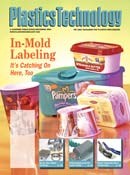1955-2005: Half a Century Of Plastics Technology
"A new industrial magazine is born." Fifty years ago, those words headlined the editor's opening statement in the first issue of PLASTICS TECHNOLOGY.
"A new industrial magazine is born." Fifty years ago, those words headlined the editor's opening statement in the first issue of PLASTICS TECHNOLOGY. Fifty years is a long time in the life of a magazine—more like a century is to a human lifetime. Relatively few go the distance, but a magazine has the advantage of renewing itself continually so that it can remain as vigorous and creative at the end of that span as at the beginning.
The covers displayed here hint at some changes in a half century, both for PLASTICS TECHNOLOGY and the readers it serves. Aesthetic standards have obviously improved for both plastics products and plastics magazines. The scope of "new fields to conquer"—as our first cover fearlessly declared—may have seemed as limitless as the universe in 1955. For today's plastics engineers, the frontiers to be crossed are often shaving a few ounces off the weight of a product or a few pennies off the cost.
In the first issue of PLASTICS TECHNOLOGY, the chief editor addressed the magazine to "the technical men" in plastics. Plastics ceased to be a man's world a long time ago, and PLASTICS TECHNOLOGY was ahead of most of its competitors in sending women out into the field as reporters or advertising salespersons.
That first-issue editorial also addressed the new magazine to readers in "production, research, development, sales service, and management." In those days, perhaps, a plastics magazine could hope to be all things to all people. Back then, resin companies often developed the applications, the processes, and even the equipment. Machinery companies sometimes sold raw materials. And your average small processor had to be the jack of all trades in his company. The plastics field then was so small and close-knit that a magazine could be written equally for materials and equipment suppliers and processors. Things are somewhat different today.
That first editorial promised to carve out a distinctive niche for the new magazine. In the ensuing half-century, we did that by tuning our editorial focus like a laser to shine only on one reader—the processor. We picked him (or her) as the one who would play the central role in determining the success of this new industry.
That first PLASTICS TECHNOLOGY Editorial in 1955 ends with the declaration, "The plastics industry is now coming of age" and making the transition from "adolescence" to "maturity." One has to smile at that, but I wonder: Will today's assumption that the plastics industry and market are "mature" seem just as naïve 50 years hence?


















